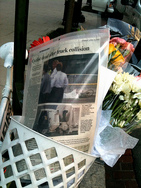Medical Examiner “accident” finding causes confusion
WTOP created some consternation among cyclists last night with its brief news item entitled, “Cyclist death officially ruled an accident.”
The article says that the Medical Examiner’s office “has ruled the death of bicyclist Constance Holden an accident.” At first blush, it looks like the city’s investigatory apparatus has again dismissed a cyclist’s death, and so quickly. However, this is not the conclusion of the crash investigation, which will take more time. This is just the medical examiner’s classification.
Medical examiners assign a “manner of death” to each fatality, and it falls into a small number of fixed categories. In DC, those are “natural, accident, suicide, homicide, undetermined, and pending.”
In short, when the Medical Examiner says “accident” here, they don’t mean “accidental” as in “unpreventable,” but “accidental” as in “not deliberate.” There’s no way for the M.E. to determine the circumstances that led to the victim being hit with “multiple blunt impact injuries.” They are basically just concluding that, for example, Ms. Holden didn’t also suffer a heart attack just before the crash, or that after the crash someone didn’t also shoot her while she was still alive.
This is a particularly clear example of the problems with using the word “accident” to talk about traffic crashes. All the Medical Examiner determined was that the crash was the cause of Ms. Holden’s death. Yet using the term “accident” as the manner of death implies that the M.E. has determined more than that; that they’ve also determined nobody was at fault. That’s not what they are saying, but many people could and did jump to that conclusion upon reading a fairly non-insightful news article.
The problems with this medical examiner’s classification scheme go beyond just traffic incidents. Last year, I sat on a jury in a murder trial. The decedent had died from falling and hitting his head on a step. The prosecution argued another man had hit him with an unknown object first, causing him to pass out and fall; the defense argued he was drunk and fell on his own.
The DC Medical Examiner classified the death a homicide. However, the defense argued that they had done so in part because they had seen the police report which talked about this other man. If there had been nobody else there, said the defense, would they still have ruled it a homicide? How did they really know? It was difficult to separate out how much of the M.E.‘s conclusion came from scientific evidence and how much came from outside information.
The Public Defender Service brought in Delaware’s Chief Medical Examiner, who said he would have ruled it an accident. Putting these classifications on seems to only serve to try to prejudice juries one way or the other. The scientific expert thinks it’s a homicide, so it must be a homicide, some might think, even though that scientific expert is really just coming to that conclusion because that’s what the police already think.
It does a disservice to Constance Holden to say that her death was “officially ruled an accident.” Her death was officially determined to have occurred as a consequence of the injuries she sustained from her encounter with a large military truck. How that truck came to be in contact with her body, and whether that was blamelessly accidental, negligence, involuntary manslaughter (a form of homicide) or something else is for the police investigators to determine, not the Medical Examiner.

